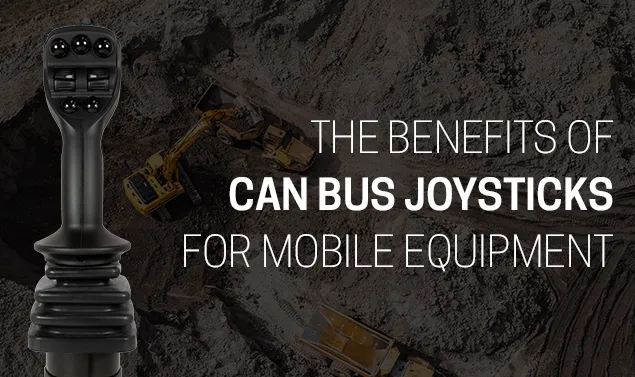
Joysticks and control systems play a pivotal role in ensuring the efficient operation of industrial equipment across various industries. The CAN bus system is one invention that has revolutionized mobile equipment and industrial machinery. This technology has simplified communication between devices and enhanced the precision and reliability of complex systems.
What is CAN Bus?
Initially developed by the automotive industry in the 1980s, CAN bus (Controller Area Network) is a serial communication protocol that allows for reliable and efficient data transfer between multiple electronic devices within a network. It consists of a robust physical layer, data link layer, and application layer, all working in synchrony to ensure consistent and error-free communication.
CAN bus operates through a differential two-wire bus also known as the CAN High (CANH) and CAN Low (CANL) lines. With a bit rate ranging from 10 Kbps to 1 Mbps, the data transmission is highly reliable and can span distances of up to 40 meters without significant signal degradation. This flexibility in terms of speed and distance makes CAN bus the preferred choice for a wide range of applications.
Key Types of CAN Protocols
J1939 is built upon the Controller Area Network (CAN) protocol, providing a reliable and robust communication system. It utilizes a hierarchical addressing scheme, allowing for various ECUs to communicate without data conflicts. J1939 is a standardized communication protocol used in heavy-duty equipment, including trucks, buses, construction equipment, and agricultural machinery.
CAN Open is a high-level communication protocol and application layer built upon the Controller Area Network (CAN) protocol. It is widely used in industrial automation and industrial machinery applications to facilitate communication between various devices, sensors, and controllers within a network. CAN Open is a standardized way for devices and nodes on a CAN bus to communicate, making integrating different types of equipment and systems easier.
The Benefits of CAN Bus
Instantaneous Communication: CAN bus enables devices to exchange information in real-time, allowing for quick and precise control of different electrical systems. This feature proves advantageous in applications that require instantaneous response and coordination, such as engine management systems, advanced driver-assistance systems, and factory automation.
Scalability: CAN bus offers high scalability, allowing for the addition or removal of devices without needing to reconfigure the entire network. As a result, maintenance and expansion become more streamlined and cost-effective, contributing to enhanced system flexibility.
Failure-resistant: Due to its inherent error detection and error correction capabilities, CAN bus is highly resistant to signal disruptions and faults within the network. This means that even if one node fails, the rest of the network can continue to operate with minimal interruptions, ensuring safety and system availability.
Why Choose a CAN Bus Joystick for Your Application?
Reliability: CAN bus joysticks are built to withstand harsh industrial environments, where electrical noise, interference, and challenging operating conditions are common. The use of differential voltage signaling and error-checking mechanisms enhances the joystick's reliability.
Adaptability: CAN bus joysticks support numerous devices, from simple sensors to complex control units, making them suitable for diverse applications.
Real-time Communication: CAN bus joysticks allow for real-time communication with the equipment they control, which is a critical feature for safety-critical applications and precision operations.
Reduced Wiring Complexity: One of the major advantages of CAN bus joysticks is the ability to simplify wiring. Utilizing a single communication bus system eliminates the need for extensive point-to-point wiring and reduces overall complexity, resulting in cost and time savings during installation or maintenance.
Even as technology continues to advance, CAN bus plays a crucial role in enabling seamless communication between various devices within mobile equipment industries. Its robustness, scalability, flexibility, and failure-resistance nature make it invaluable for use in industrial and mobile equipment joystick applications. Although traditional methods of electronic output types, such as Hall-Effect or potentiometers, can be reliable solutions, CAN bus is often chosen for joysticks in on and off-highway equipment applications.